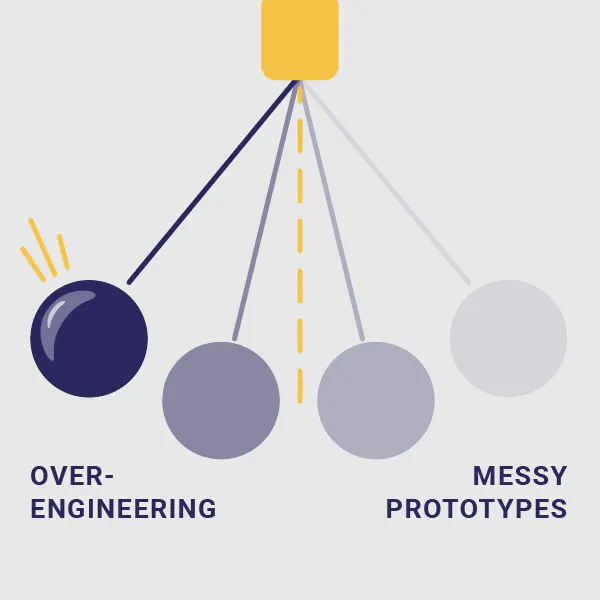Blog Posts
- Home /
- Blog Posts

Iteration #1: "Go Faster"
We registered Three Dots Labs as a company in 2014, hoping to quit our jobs soon to work on our products. The “soon” turned into ten years of launching side projects and working evenings and weekends. We finally decided to take the leap last year, and we plan to share how it’s going. If you’re in a similar spot, you may find it helpful.

We quit our jobs to help people write software more mindfully
Leaving a principal software engineer role while having a newborn kid, a mortgage to pay, and a house being built may not sound like the best idea. Still, I took a significant pay cut so I could make a living by educating people about software. Some people literally told me that I’m crazy. Well, Miłosz (the co-founder of this blog) and I decided to build a company we love to work at without VC funding.

The Over-Engineering Pendulum
I used to picture my dream job as this: I work for an early-stage startup that recently raised a round. The business idea is promising, there’s much to build, everything seems possible, and we have time to prove the product-market fit. I join as the first engineer, lay the foundations, and pick the tech stack. Can you imagine a better gig?

Watermill 1.4 Released (Event-Driven Go Library)
It’s Autumn over here, and it usually means another release of Watermill! 🍂 It’s hard to believe it’s already been five years since the v1.0 release. In case you’re new to Watermill, here’s TL;DR. Watermill is a Go library for building message-driven or event-driven applications the easy way. Think of it like an HTTP router but for messages. It’s a library, not a framework, so you don’t need to change your architecture to use it.

Optimising and Visualising Go Tests Parallelism: Why more cores don't speed up your Go tests
Recently, I struggled for a couple of hours to understand why the API tests of one project were slow. In theory, we designed tests to run in a fully parallel way – the duration of tests should be close to the longest-running test. Unfortunately, the reality was different. Tests took 7x longer than the slowest test without using 100% available resources.

Distributed Transactions in Go: Read Before You Try
In the previous post, I looked into running transactions in a layered architecture. Now, let’s consider transactions that need to span more than one service. If you work with microservices, a time may come when you need a transaction running across them. Especially if the way they are split was an afterthought (the unfortunate but likely scenario). Service A calls service B, which calls service C, and if something goes wrong at the end, the system becomes inconsistent.

Database Transactions in Go with Layered Architecture
As I join a new company, I often feel like an impostor. After all the interviews, they really seem to know what they’re doing. I’m humbled and ready to learn from the best. On one such occasion, a few days in, I dealt with a production outage and asked the most senior engineer for help. They came to the rescue and casually flipped a value in the database with a manual update.

Live website updates with Go, SSE, and htmx
In case you missed the memo, the Single Page Application hype period is over, and we’re now back to PHP and jQuery, I mean rendering HTML on the server. I’m excited! It brings me back to the early 2000s when we were all web developers, not frontend or backend engineers. But there’s one thing I would miss from the SPA era: live updates.

Making Games in Go for Absolute Beginners
Here’s a rant I often see in developer communities: I used to love programming because I like building stuff. But my full-time job killed my passion. I spend more time in meetings, fighting over deadlines, and arguing in reviews than working with code. Am I burned out? Is there hope, or do I need a new hobby? Sounds familiar? No wonder we keep looking forward to using a new framework or database — we’re bored.

Watermill 1.3 released, an open-source event-driven Go library
Hey, it’s been a long time! We’re happy to share that Watermill v1.3 is now out! What is Watermill Watermill is an open-source library for building message-driven or event-driven applications the easy way in Go. Our definition of “easy” is as easy as building an HTTP server in Go. With all that, it’s a library, not a framework. So your application is not tied to Watermill forever.
Series
Popular articles
- The Go libraries that never failed us: 22 libraries you need to know
- Safer Enums in Go
- Common Anti-Patterns in Go Web Applications
- How to implement Clean Architecture in Go (Golang)
- The Repository pattern in Go: a painless way to simplify your service logic
- Introduction to DDD Lite: When microservices in Go are not enough
Tags
- go
- golang
- watermill
- ddd
- clean-architecture
- domain-driven design
- events
- web-applications
- anti-patterns
- event-driven
- software-development
- ci
- firestore
- architecture
- cloudrun
- gcloud
- googlecloud
- serverless
- testing
- advanced
- databases
- devops
- firebase
- gitlab
- microservices
- reactive
- repository
- backend
- basics
- building-business-applications
- building-in-public
- cqrs
- frameworks
- kafka
- mysql
- nats
- pipelines
- scalability
- software-architecture
- transactions
- amqp
- authentication
- balance
- bounded-context
- c4
- cicd
- code-quality
- code-review
- design-patterns
- diagrams
- docker
- dry
- e-book
- efficiency
- enums
- event-storming
- gamedev
- generics
- google-cloud
- grpc
- htmx
- intermediate
- iteration
- javascript
- learning
- libraries
- maintainability
- metrics
- monolith
- open-source
- openapi
- over-engineering
- overengineering
- parallelism
- productivity
- programming-languages
- prometheus
- pull-requests
- python
- rabbitmq
- retrospective
- security
- sql
- sse
- startups
- strategic-ddd
- swagger
- terraform
- tips
- unpopular-opinions
- versioning